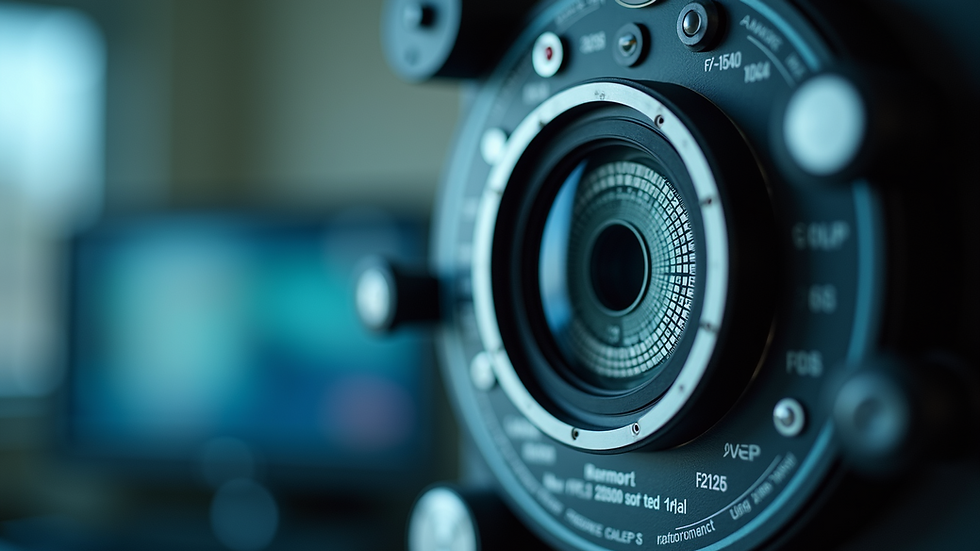How to Ensure Your Ophthalmic Tools Stay in Top Condition
- gfischersv
- May 21
- 4 min read
Maintaining the quality of your ophthalmic tools is essential for providing excellent patient care. Just like any medical equipment, these tools require proper attention and handling. Regular upkeep not only prolongs their lifespan but also ensures accurate diagnoses and treatments. Here’s how to make sure that your ophthalmic tools remain in peak condition.
Understanding Ophthalmic Tools
Ophthalmic tools are specialized instruments used in eye care practices. They range from simple devices such as eye charts to complex machinery like optical coherence tomography (OCT) machines. Proper usage and care of these tools are crucial, as they play a vital role in the precision of diagnoses and the effectiveness of treatments.
Maintaining these instruments isn’t just about cleaning; it involves a comprehensive approach to ensure their performance and functionality.

Best Practices for Cleaning and Maintenance of Ophthalmic Tools
Regular cleaning and maintenance are essential to extend the life of your ophthalmic tools. Here are some practical steps to follow:
Use Appropriate Cleaning Solutions: Always use the recommended cleaning products for your specific tools. Many ophthalmic devices are sensitive to certain chemicals that can cause damage.
Follow a Schedule: Create a dedicated cleaning schedule based on usage frequency. Instruments that are used daily may require daily cleaning, while those used less often can be cleaned weekly.
Store Properly: After cleaning, ensure that tools are stored in a secure place. Use protective cases when applicable to avoid scratches and other damage.
Regular Inspections: Frequently inspect your tools for any signs of wear and tear. Look for rust, corrosion, or loose parts, and address issues as soon as they arise to prevent severe damage.
Professional Servicing: For more complex instruments, consider professional maintenance. Explore options like clinical equipment maintenance to ensure that your tools are regularly serviced by experts.

What are the 4 Types of Maintenance?
Understanding the types of maintenance can help you choose the right approach for caring for your ophthalmic tools. There are four primary types:
Preventive Maintenance: This consists of routine inspections and maintenance activities performed to prevent breakdowns before they occur. Regular cleaning, calibration, and replacement of worn parts fall under this category.
Corrective Maintenance: When a piece of equipment fails, corrective maintenance comes into play. This type involves fixing the instrument to restore its functionality.
Predictive Maintenance: Utilizing advanced diagnostics and monitoring tools, predictive maintenance anticipates failures before they happen. This proactive approach often involves analyzing performance data.
Total Productive Maintenance (TPM): TPM is a collaborative effort that engages all employees in maintenance processes. This approach encourages everyone to participate in sustaining equipment performance and minimizes downtime.
Implementing these maintenance practices can substantially enhance the reliability and performance of your ophthalmic tools.

Training Staff on Proper Handling of Ophthalmic Tools
The first line of defense in maintaining your instruments is ensuring that all staff members are trained in proper use and care. Here are some key training points to consider:
Hands-On Training: Provide practical demonstrations to show staff how to handle the tools correctly. This should include how to clean, store, and troubleshoot issues with each instrument.
Create a Manual: A comprehensive manual detailing the best practices for each ophthalmic tool can serve as an ongoing resource for staff. Include cleaning protocols, maintenance schedules, and troubleshooting tips.
Continual Education: Schedule periodic training sessions to keep staff informed about new tools, techniques, and changes in standard procedures.
Emphasize Accountability: Encourage staff to take ownership of the tools they handle. This sense of responsibility fosters a culture of care and diligence, which translates to better outcomes for patient care.
Keeping Records for Maintenance Activities
Keeping accurate records is a cornerstone of effective maintenance practices. Here’s how to keep your records organized:
Log Maintenance Schedules: Create a maintenance log for each tool, noting cleaning dates, inspections, and any repairs made. This helps in tracking the tool's history and evaluating if additional maintenance is needed.
Track Usage Patterns: Monitor how frequently each tool is used. This data can help in scheduling preventive maintenance and assesses whether your inventory meets clinical demand.
Review and Adjust: Regularly review your maintenance records to identify trends. If certain tools require frequent repairs, you may need to consider replacing them or changing your maintenance approach.
Utilize Software Solutions: Consider using management software tailored for medical equipment. These tools can automate reminders for maintenance checks, log incidents, and provide insights into equipment performance.
Steps for Ensuring Compliance with Regulatory Standards
Maintaining compliance with regulatory standards is essential for any healthcare practice. Here are steps to ensure that your ophthalmic tools meet all necessary regulations:
Stay Updated on Regulations: Familiarize yourself with the current regulations governing medical equipment in your region. This can include the FDA guidelines, ISO standards, and local health authority regulations.
Conduct Regular Audits: Schedule internal audits to ensure compliance with cleaning and maintenance protocols. Identify areas of improvement and implement necessary changes.
Documentation: Ensure that all maintenance and inspection records are meticulously documented and readily accessible. This documentation not only assists in demonstrating compliance but also aids in quality assurance practices.
Educate Staff on Compliance: Incorporate compliance training into your staff orientations and ongoing training. Knowledge of regulatory requirements helps ensure that everyone is on the same page regarding maintenance practices.
Final Recommendations for Maintaining Ophthalmic Tools
To sum up, ensuring your ophthalmic tools remain in optimal condition requires a systematic approach. Focus on cleaning, staff training, proper storage, and documentation of maintenance activities. By placing a premium on careful use and proactive maintenance, you safeguard your investment in these essential instruments and enhance your clinic's ability to provide quality care.
Adopting these practices ensures you are prepared to handle any issues that may arise with your tools. Consistency, vigilance, and a commitment to excellence will not only keep your ophthalmic tools in top condition but will also improve patient trust and satisfaction in your practice.





Comments